
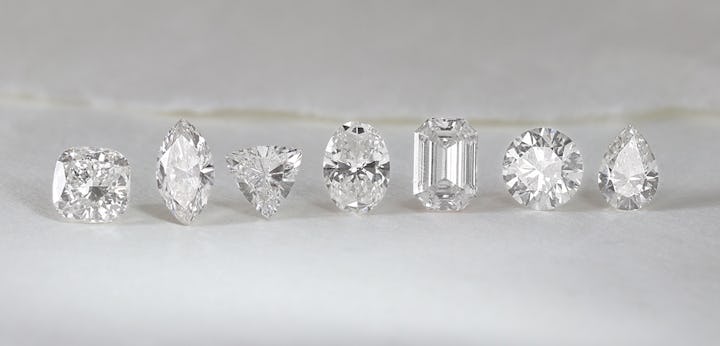
Diamond Inclusions Guide: What Are Diamond Inclusions?
Angelica Frey & Alicia Briggs | August 07, 2023
Diamond inclusions have oftentimes been portrayed as the hallmark of a diamond’s imperfection and as the main reason for a cloudy appearance. Inclusions determine a diamond’s clarity grade and can impact its appearance and value. But they are largely unavoidable. Inclusions are a foundational and natural characteristic of a diamond and a great marker of its identity.
Understanding what inclusions are and the different types of inclusions will help you make an informed decision when choosing a diamond. Read on to learn how to buy a beautiful lab-grown diamond based on their inclusions and clarity characteristics.
What Is a Diamond Inclusion?
Diamond inclusions are small imperfections within a diamond. Inclusions are formed because of the tremendous heat and pressures needed in the diamond creation process.
A diamond is made of around about 99.95% of carbon. The remaining 0.05 percent can include one or more trace elements, which are atoms that aren’t part of a diamond’s essential chemistry. The presence of these trace elements is what causes the appearance of inclusions.
Inclusions vs. Blemishes
Both inclusions and blemishes are “imperfections” in a diamond that influence its overall appearance and clarity grade. But inclusions and blemishes are not the same thing. Inclusions refer to a diamond’s internal compositional flaws while blemishes refer to any external flaws on the diamond’s surface.
Be the first to know
Hear about our latest designs and upcoming events.
What Causes Inclusions in Diamonds?
During the formation process of a diamond, small crystals can become entrapped in the carbon grid. Sometimes, that crystal grows and develops, forming an inclusion called grain lines.
Inclusions are what make a diamond unique. Just like no two people have the same fingerprints, the same can be said about diamonds and inclusions. A diamond’s inclusion can be a great identifier. They can be a feature, not a flaw.
Do Diamond Inclusions Matter?
Inclusions do matter. Inclusions are an essential factor when it comes to determining a diamond’s clarity, which is one of the diamond 4Cs. As such, inclusions impact a diamond’s overall value. Slightly included diamonds can still be valuable and very desirable depending on their otherh characteristics.
While most diamonds have inclusions, the type and location of the inclusion will determine how much it impacts a diamond's overall appearance.
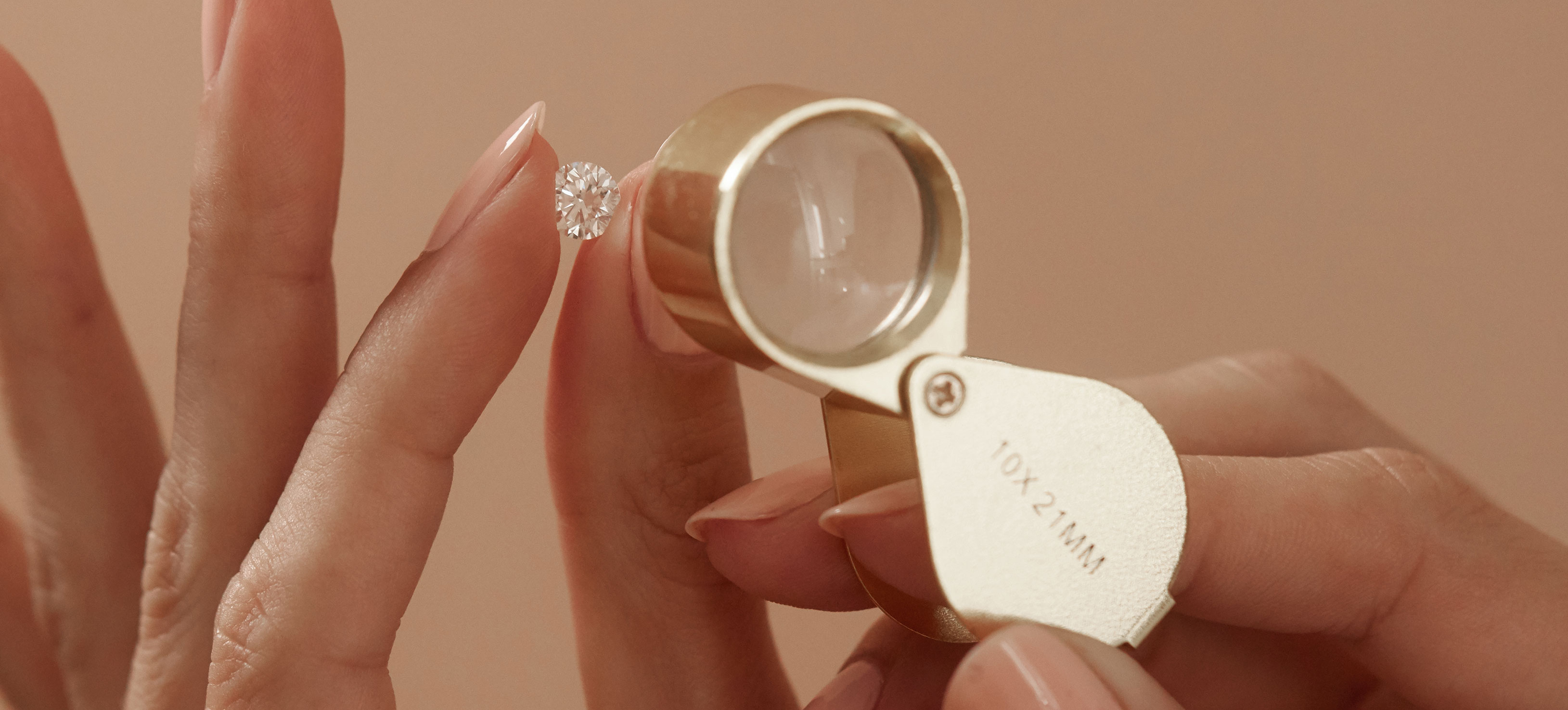
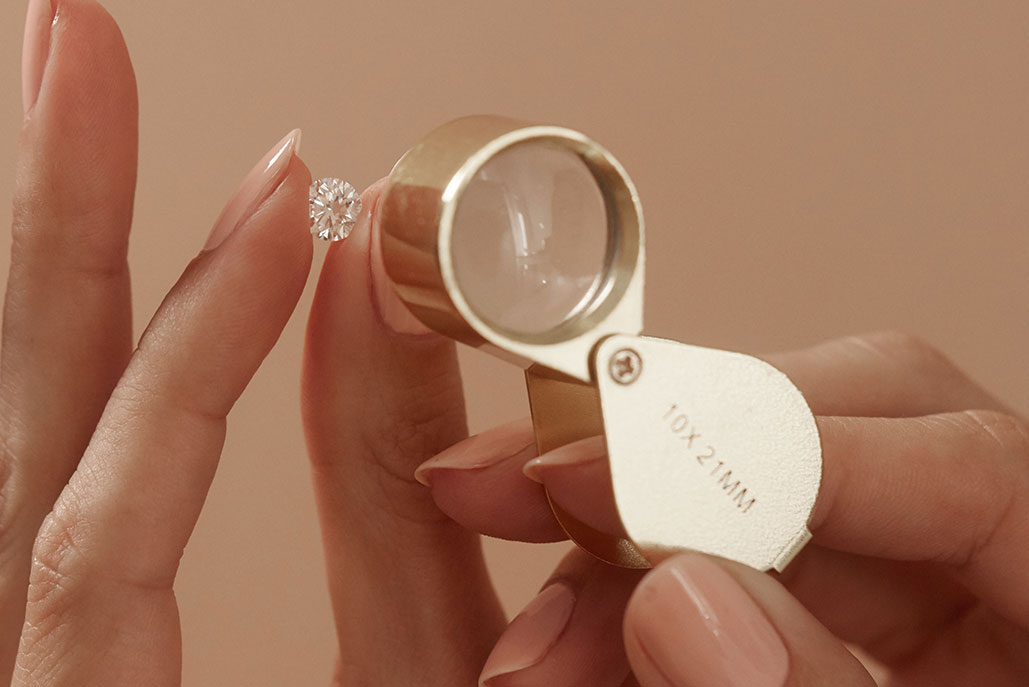
Types of Diamond Inclusions
Not all inclusions are the same. Inclusions can be reminiscent of small indentations, hairline fractures, darker dots, cloud-like formations, patches of color, or thin needles.
Different-looking inclusions are different types of inclusions. Diamond inclusion variations will influence how they affect a diamond’s appearance and clarity grade. You can find the different diamond inclusion types below.
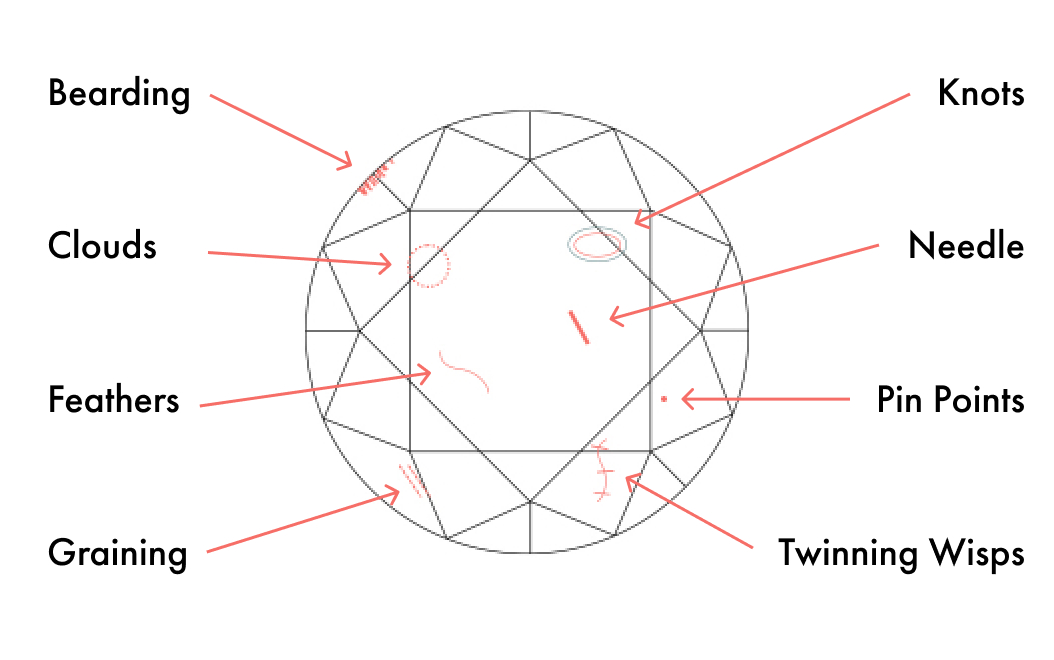

Bearding
Bearding consists of hair-like lines that extend from the girdle into the surface of the stone. They are a result of the cutting process of a diamond. Heavy bearding will give a diamond a cloudy and fuzzy appearance.
Cloud
In terms of diamond inclusions, a cloud consists of tightly grouped pinpoints (at least three) that might be too small to distinguish individually but together have a hazy appearance. They do not affect the durability of the stone.
Crystal
A crystal is another mineral included in a diamond. A crystal can be colorless when another diamond is embedded within the diamond. It will be black in the case of carbon, reddish in the case of garnets, or greenish in the case of peridots.
Feather
A feather is a break in the diamond, and its name derives from its feather-like appearance. Feathers are a type of inclusion you need to pay attention to. Depending on their location, they can make a diamond more prone to chipping and cleaving.
Internal Graining
Graining is an irregular internal crystal growth with a milky or hazy appearance. It can also sport faint lines or streaks.
Knot
A knot is an included diamond crystal that extends to the surface. Unlike the crystal inclusion, a knot affects the durability of the diamond.
Needle
A needle is a type of rod-shaped crystal inclusion occurring in a diamond.
Pinpoint
A pinpoint is a tiny white or black inclusion, only a few micrometers in size.
Twinning Wisp
Twinning wisps are veils of tiny needles, clouds, pinpoints, and crystals running along the diamond's twinning plane, caused by growth distortion.
Indented Natural
Indented naturals are internal markings or grooves, often triangular, that are caused when part of the crystals from a rough diamond’s surface sinks beneath during formation.
Bruise
A bruise is a small area with tiny feathers extending from it, creating a cotton-like texture.
Are Inclusions Visible to the Eye?
Most inclusions are only detected through 10x magnification and are still considered eye-clean. The visibility of an inclusion depends on size and placement. For example, a carbon inclusion on a VS2 diamond at the center of its table is more visible than a crystal inclusion on the crown near the girdle in a SI1 diamond.
Certain diamond shapes and diamond cuts will also determine how visible an inclusion is to the naked eye. Brilliant cut diamonds will hide inclusions better than step cut diamonds.
In addition, carat size affects the visibility of inclusions. The higher the carat weight, the more visible the inclusions can be. You will need higher clarity grades for larger diamonds for them to stay eye-clean.
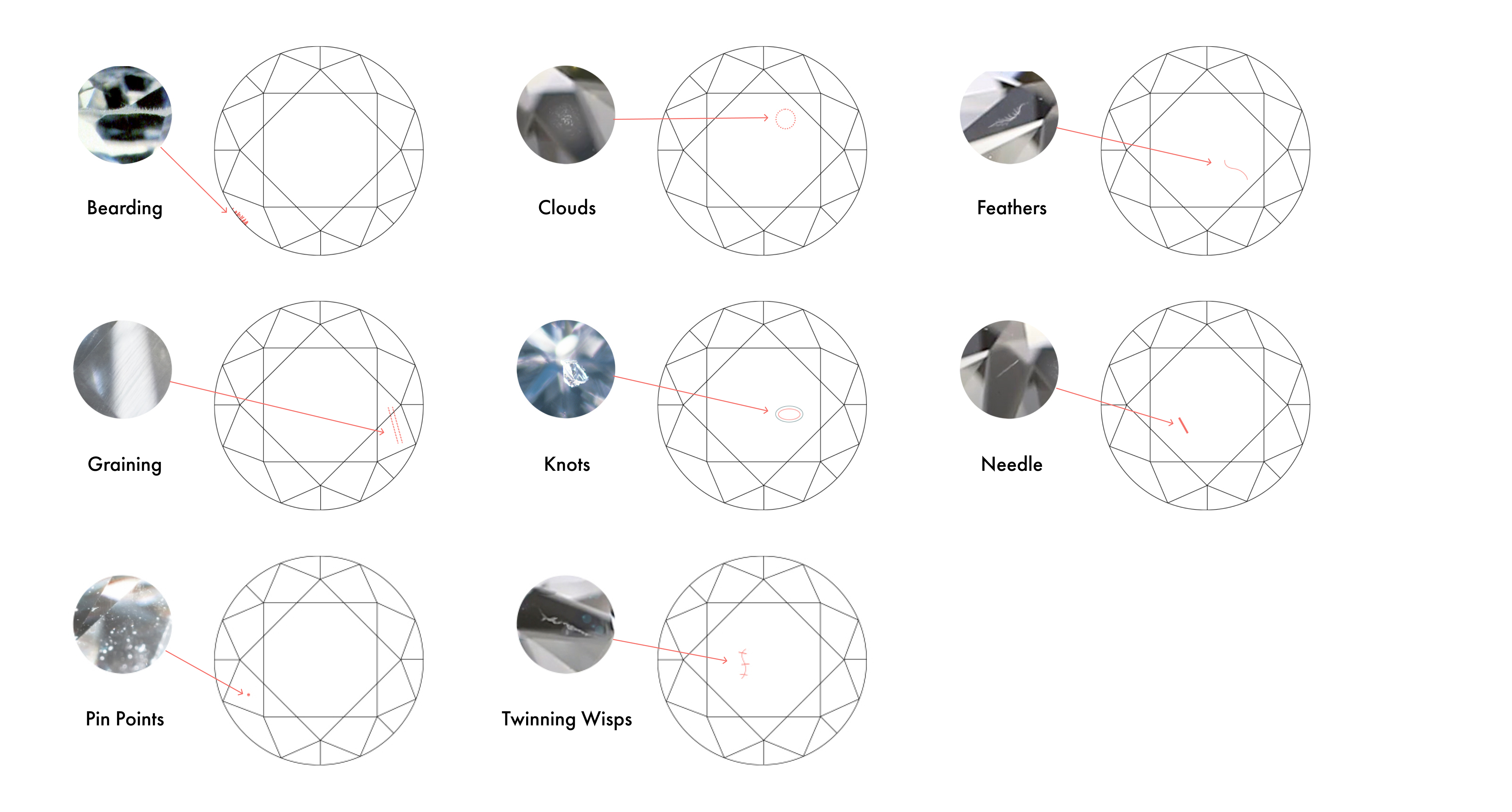

Inclusions and Diamond Grading
Inclusions will impact the overall [diamond grade](/journal/post/diamond-grading). They will also determine which diamond cut and clarity grade you should choose, as well as the best diamond shape.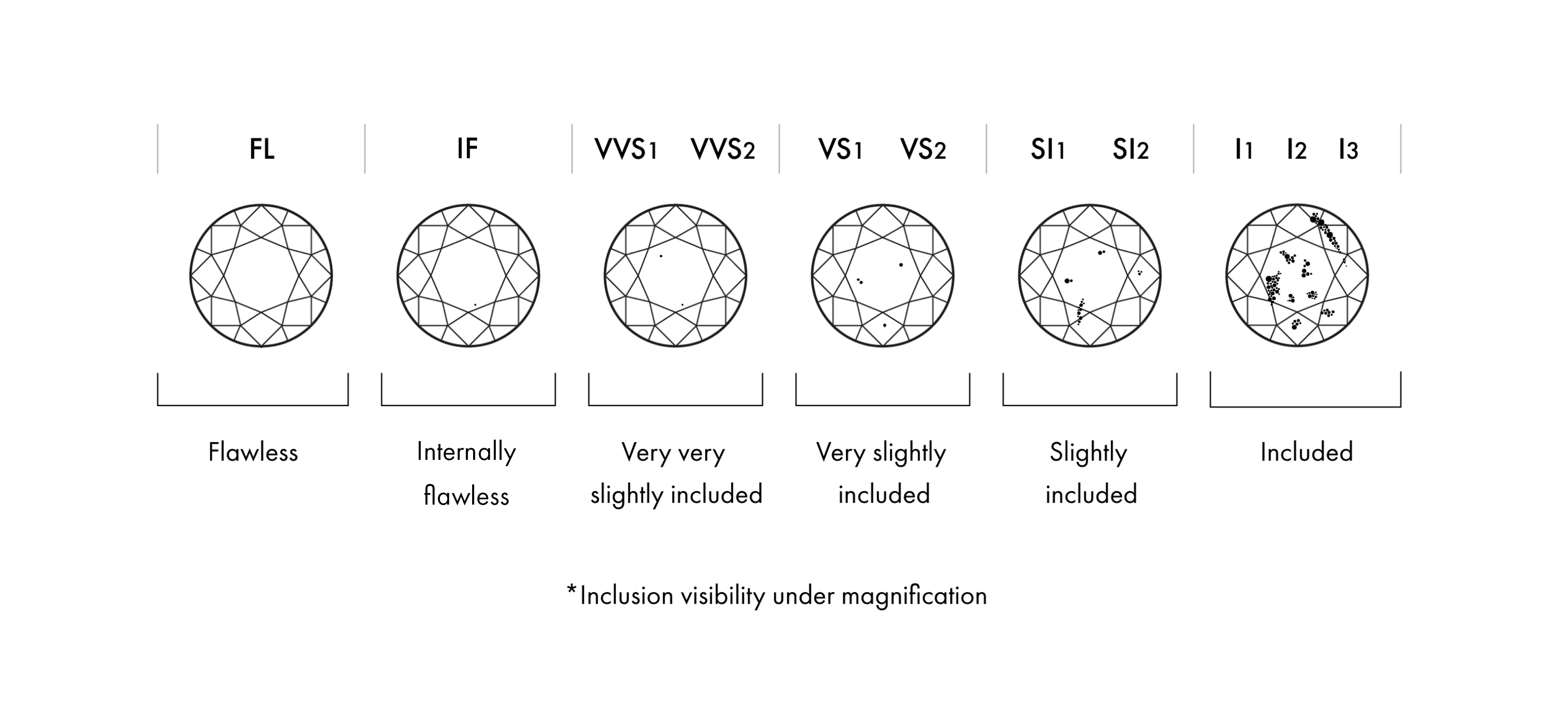
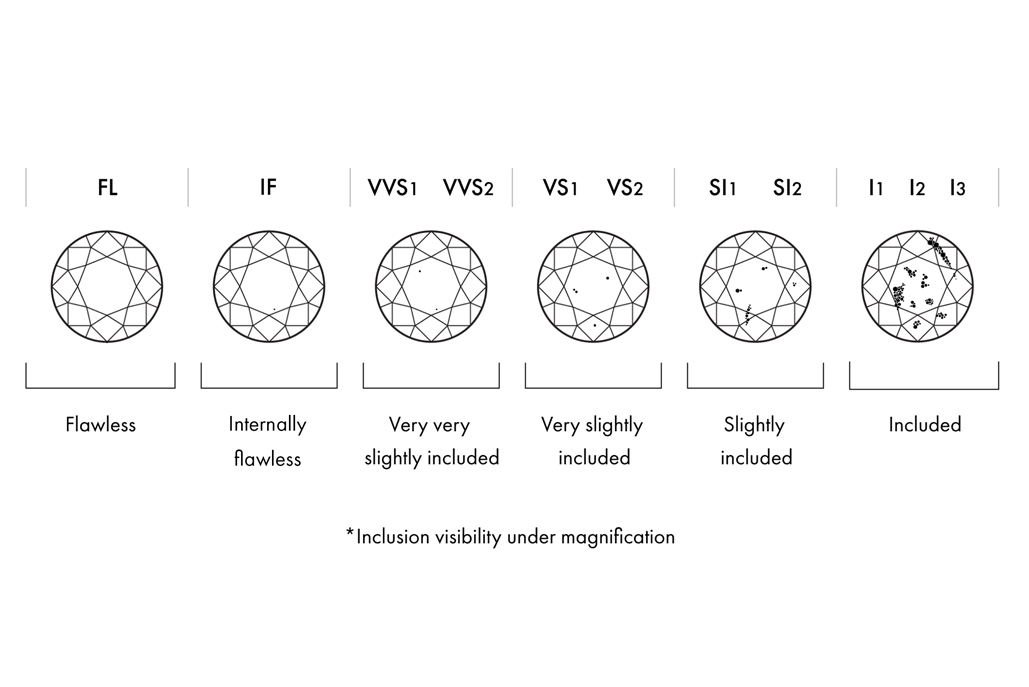
Diamond Clarity and Inclusions
The presence and nature of inclusions largely determine a diamond’s clarity grade. The fewer inclusions, the higher the clarity grade. But as mentioned above, inclusions aren’t always visible. You rarely need to choose the highest clarity grades (Flawless and Internally Flawless) to have an eye-clean diamond.
Flawless diamonds are very rare, so the highest clarity grade you’ll often see is VVS. But even a VVS clarity grade isn’t always necessary. Diamonds with a VS clarity grade have inclusions but they will often still appear clear to the naked eye. Depending on the diamond shape and the remaining 4Cs, an S1 or VS diamond can still provide a brilliant, clear diamond.
Inclusions and Diamond Cut
Different diamond cuts, and diamond shapes, can affect the appearance and visibility of inclusions.
Brilliant cut diamonds have 57-58 facets which are either triangle or kite-shaped. This makes inclusions harder to spot. The high number of facets makes the light bounce around in a way that creates a visual pattern that conceals inclusions. With diamond shapes that have brilliant cuts, such as Round Brilliant and Oval diamonds, you can often find eye-clean diamonds for a lower clarity grade.
Step cut diamonds, such as Emerald and Asscher cut diamonds, have fewer and larger parallel-shaped facets. This makes inclusions more visible because of the less dynamic way light bounces off of them. When buying a step cut diamond, prioritize clarity over the other 4Cs.
Other diamond shapes, like Radiant cut and Princess cut diamonds, have faceting structures that will help conceal inclusions. Our diamond experts can help you choose the right clarity grade for each diamond cut and diamond shape.
How to Buy Diamonds With Inclusions
Almost all diamonds have inclusions. If you’re planning on buying a diamond, chances are, it will have some inclusions.
“Inclusions are sort of like a freckle or a birthmark inside a diamond - there's nothing wrong with them and they occur naturally,” explains Grace Taylor, VRAI’s Sr. Director of Sales & CX. “They can be really charming if you don't mind them. They can act as an immediate way to know your diamond is your diamond.”
However, there are certain inclusions to avoid to ensure you’re buying a beautiful diamond. Our VRAI diamond experts can help you select the right diamond for you.
Diamond Inclusions to Avoid
While all diamonds have inclusions, certain inclusions should be avoided when buying a diamond. “The main thing you want to avoid is an inclusion that breaches the surface of a diamond. These can cause structural deficiencies and can lead to the diamond cleaving or breaking if hit at the right angle,” explains Taylor.
Lab-grown diamonds grown through the HPHT process can have metallic inclusions which causes them to be slightly magnetic. These types of inclusions don’t occur in mined diamonds or in CVD created lab-grown diamonds. All VRAI created diamonds are made through CVD.
Other inclusion types are more prominent which means you may want to avoid them if they are located in a highly visible area of the diamond. “If you're sensitive about inclusions, you want to avoid inclusions that are smack-dab in the middle of the diamond as those are much more likely to be visible to the naked eye,” warns Taylor.
Diamond Inclusion FAQs
Read on for any remaining questions you may have about diamond inclusions.
Do All Diamonds Have Inclusions?
The only diamonds that do not have inclusions are flawless diamonds but flawless diamonds are extremely rare. All diamonds of all origins can and do have inclusions. That’s because chemically and physically, lab-grown diamonds and mined diamonds are identical.
Mined diamonds have inclusions because, when the diamonds are formed in the mantle of the earth, atoms of other elements and crystals insert themselves within the carbon crystal structure.
Because a lab setting recreates the same conditions of heat and pressure that are found in the Earth’s mantle, lab-grown diamonds also have inclusions. They are remnants of the growth process and can come in a variety of aspects that fully resemble the ones occurring in mined diamonds.
Both mined and lab-grown diamonds occasionally produce flawless diamonds, which are rare and very valuable.
Do Lab-Grown Diamonds Have Fewer Inclusions?
Lab-grown diamonds don’t necessarily have fewer inclusions than mined diamonds. Mined and lab-grown diamonds have to undergo the same formation process. Both a lab and the Earth’s mantle present variables within their formation environment, which will result in the appearance of inclusions.
What Are the Most Common Diamond Inclusions?
“The most common inclusions CVD diamonds will have is non-diamond carbon. This presents as black inclusions within the diamond. Very similar inclusions are also found in mined diamonds,” says Taylor.
Can You Fix an Inclusion in a Diamond?
“Inclusions are a natural part of a diamond, just like freckles or birthmarks on a human being. It’s not possible to change whether or not inclusions are in a diamond,” explains Taylor. “If inclusions bother you, make sure to purchase an eye-clean diamond. If visible inclusions don’t bother you, you can find a great value diamond for any size and your unique diamond inclusions will be like its own little birthmark."
One way to minimize any visible inclusions is to regularly clean your diamond. “If you have small visible inclusions in your diamond, they’ll be more obvious to the eye if the diamond is dirty,” Taylor recommends.
Depending on the location of the inclusion, you can use the ring setting to hide visible inclusions. A Bezel setting can hide inclusions in the pavilion, while a strategically placed prong can hide inclusions in the girdle.
Do Inclusions Weaken a Diamond?
Most inclusions found in jewelry-grade diamonds won’t affect a diamond’s durability but certain types of inclusions can weaken a diamond. Particularly deep or long inclusions, like needle inclusions, can decrease the strength of a diamond.
Do Diamond Inclusions Affect Sparkle?
Inclusions don’t necessarily affect a diamond’s brilliance. Most inclusions are only seen under 10x magnification, but when they’re located in the middle of the table or in step cut diamonds, their presence is more noticeable. In addition, larger and deeper inclusions can give diamonds a cloud-like appearance. These factors can impact the brilliance of the diamond.
Since no two inclusions are alike, it’s advisable to inspect a diamond firsthand to ensure it has the brilliance you desire. VRAI offers complimentary appointments with our diamond experts for personalized guidance in choosing the right diamond for you.
Can Diamonds Form New Inclusions?
No, diamonds cannot form new inclusions. Inclusions are only created during the diamond formation process so new inclusions will not appear once the diamond is formed.
Can Diamond Inclusions Get Worse?
Diamond inclusions cannot get worse. Inclusions won’t grow or change after they are formed.
Shop VRAI Created Diamonds
Recognizing, discerning, and distinguishing inclusions can be a time-intensive endeavor and overwhelming for less experienced diamond shoppers. At VRAI, we only sell beautiful and brilliant lab-grown diamonds with S1 clarity grades or above.
Our diamonds are grown in the world’s first zero-emission foundry and expertly cut and polished to ensure a high-quality lab-grown diamond. Explore our full inventory of VRAI created diamonds with the help of a VRAI diamond expert to choose the right lab-grown diamond for you.